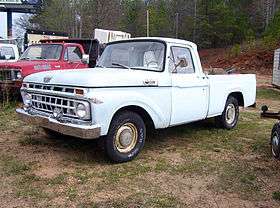Ford F-Series (fourth generation)
The fourth generation of the Ford F-Series is a line of pickup trucks and commercial trucks that were produced by Ford from October 1960 to August 1966. Sleeker and wider than its predecessor, the new F-Series introduced several firsts to the truck line. In Canada, the F-Series continued to be distributed by Mercury dealers as the M-Series.
1960–1962
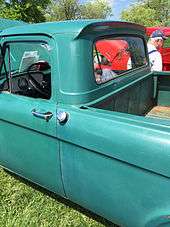
Along with the traditional separate Styleside/Flareside boxes, Ford introduced unibody trucks. These were originally named as the "integrated pickup" and consisted of the cab and the box into one continuous piece, with no gap between them.[2] The design required fewer stampings, such as the back of the cab served as the leading edge of the bed, less complicated assembly, such as the single-wall bed sides were spot-welded directly to the door sills, and the body had a less complicated path through the assembly plant's paint shop.[2] This achieved cost savings in the manufacture of the truck, but the one-piece cab and box body was still mounted to a traditional frame-style chassis.[2]
1962–1965
Due to poor market reception, and rumors that overloading caused the doors to jam shut, the unibody trucks were dropped midway through 1963 model year. The result was that some 1962 and 1963 trucks use the bed from the 1957 through 1960 style. Also, 1963 and 1964 4X4 used the 1957-1960 bed. The 1963-64 models have the turn signals in the grill. From 1964 onward, the flare over the rear wheel arch was extended out to the taillights, rather than flowing over the wheel opening.
1965-1966
In October 1964, the 1965 F-Series was introduced an all-new frame, which would then be used on the F-Series until 1979. In contrast, the body remained largely unchanged, but the 1965 and 1966 models the turn signals are above the headlights. Replacing the rudimentary straight-axle in the front was all-new independent "Twin I-Beam" suspension with coil springs on two-wheel-drive trucks.[3] The 1965 and 1966 F-Series trucks are distinguished with a "TWIN I-BEAM" emblem on the front fender. The F-Series also included a 4-door crew-cab model.
The 240 cu in (3.9 L) and 300 cu in (4.9 L) straight six was introduced. With the introduction of the 208 hp (155 kW; 211 PS) 352 cu in (5.8 L) FE V8, output surpassed 200 hp in the F-Series for the first time.
Mexican assembly 1965-1966
New automotive assembly regulations and laws favoring domestic manufacture over imports were decreed by the Mexican government in 1962. After decades of Ford trucks built in Mexico from imported assembly kits, 1965 was the first Mexican-built Ford truck in the recently-open Cuautitlán Assembly in Cuautitlán Izcalli. The models included the F-100 (1/2 ton pickup model), F-350 (1 ton truck model) and F-600 (5 ton truck). The F-100 came in two versions: a chassis cab and pickup truck with a like-Ford F-Series third generation bed). The trucks were fitted with the 289 cu in (4.7 L) V8 engine that was introduced in the Mexican market of Ford pickups and medium-duty trucks, producing 160 hp (119 kW; 162 PS) at 4,000 RPM. These engines were also used the Ford Mustang that was also manufactured in the Cuautitlán Assembly in Mexico.
Models
- F-100 (F10, F14): 1/2 ton (4,000–5,000 GVWR max)
- F-100 (F11, F18, F19)(4×4): 1/2 ton (4,000–5,600 GVWR max)
- F-250 (F25): 3/4 ton (7,400 GVWR max)
- F-250 (F26)(4×4): 3/4 ton (4,900 GVWR max)
- F-350 (F35): 1 ton (9,800 GVWR max)
A Camper Special was available featuring heavier-duty components to accommodate the slide in campers that were becoming increasingly popular during this time.
For 1965, the Ranger name first appeared as a styling package for the F-Series pickup trucks. The interior featured bucket seats and a curtain over the gas tank which was behind the seats in the cab.
- Fourth-generation Ford F-Series (hover over image for caption)
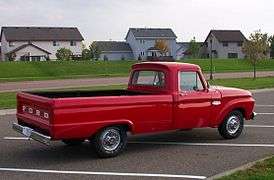 1966 Ford F-100 with optional toolbox in side of bed
1966 Ford F-100 with optional toolbox in side of bed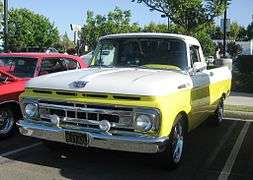 1961 Ford F-100 Pickup
1961 Ford F-100 Pickup- 1962 Mercury M-100
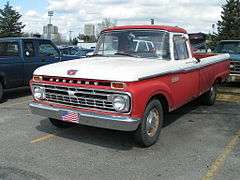 1966 Mercury M-100
1966 Mercury M-100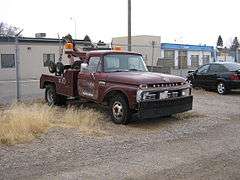 1966 Mercury M-350 Tow Truck
1966 Mercury M-350 Tow Truck
Powertrain
| Engine | Years | Power |
|---|---|---|
| 223 CID Mileage Maker I6 | 1961–64 | 114 hp (85 kW) |
| 262 CID Mileage Maker I6 | 1961–64 | 132 hp (98 kW) |
| 292 CID Y-block V8 | 1961–64 | 170 hp (130 kW) |
| 240 CID Straight-6 | 1965–66 | 150 hp (110 kW) |
| 300 CID Straight-6 | 1965–66 | 170 hp (130 kW) |
| 289 CID Windsor V8 (Mexican market) | 1965–66 | 160 hp (120 kW) |
| 352 CID FE V8 | 1964–66 | 208 hp (155 kW) |
References
- ↑ "1965 Ford Truck Full Line Brochure". Oldcarbrochures.com. Retrieved 2012-03-03.
- 1 2 3 Levine, Mike (17 February 2010). "Looking Back: 1961-63 Ford F-100 "Unibody" Pickups". pickuptrucks.com. Retrieved 1 October 2015.
- ↑ Fitzgerald, Craig (June 2008). "Ford's Twin I-Beam Front Suspension". Hemmings Motor News. Retrieved 25 January 2018.
« previous — Ford Motor Company light truck timeline, North American market, 1946–1979 — next » | ||||||||||||||||||||||||||||||||||
|---|---|---|---|---|---|---|---|---|---|---|---|---|---|---|---|---|---|---|---|---|---|---|---|---|---|---|---|---|---|---|---|---|---|---|
| Type | 1940s | 1950s | 1960s | 1970s | ||||||||||||||||||||||||||||||
| 6 | 7 | 8 | 9 | 0 | 1 | 2 | 3 | 4 | 5 | 6 | 7 | 8 | 9 | 0 | 1 | 2 | 3 | 4 | 5 | 6 | 7 | 8 | 9 | 0 | 1 | 2 | 3 | 4 | 5 | 6 | 7 | 8 | 9 | |
| SUV | Bronco | Bronco | ||||||||||||||||||||||||||||||||
| Coupé utility | Ranchero | Ranchero | Ranchero | Ranchero | Ranchero | Ranchero | Ranchero | |||||||||||||||||||||||||||
| Compact pickup | Courier | Courier | ||||||||||||||||||||||||||||||||
| Full-size pickup | Standard/ Deluxe |
F-Series | F-Series | F-Series | F-Series | F-Series | F-Series | |||||||||||||||||||||||||||
| Van | Econoline | Econoline | Econoline / Club Wagon | |||||||||||||||||||||||||||||||
